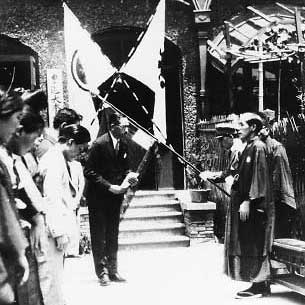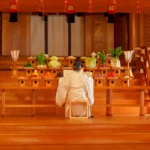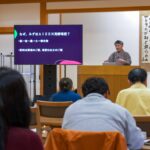World Religious Federation

Back in Japan, Onisaburo continued his inter-religious activities at a furious pace. In September 1924, he met with representatives of Futen, a newly established Korean religion, and in November, he invited Mohammed Kumon, a Muslim convert, to lecture at the Oomoto headquarters about Islam. After his release from prison in November, he began work on a project dear to his heart, the World Religious Federation.He wrote:
- As for the world religious unity Oomoto calls for, most people think this means that unless the entire world follows the teachings of Oomoto, we will not have religious unity. But religions differ naturally according to different thoughts and concepts, and when looked at from a larger point of view, it doesn’t matter whether they are called Shinto, Buddhist, or Christian. If all religious groups and thinkers act in accordance with Oomoto’s hopes, then this will be Oomoto’s world unity.
On May 22, 1925, the World Religious Federation sponsored by Onisaburo held its opening ceremony in Peking. Present were representatives from Confucianism, Islam, Tibetan Lamaist Buddhism, Futen, Christianity, Taoism, and New World Salvation, a Chinese new religion at whose headquarters the conference took place. This meeting was followed by another at the Tao Yüan headquarters in Kobe, Japan, attended by representatives from Tenri-kyo, Jodo (Pure Land) Buddhism, Hinduism, Shingon (Esoteric) Buddhism, Zen, Oomoto, and others.
Unfortunately, political events in China and Japan were moving too fast. The Feder-ation and even some of the religions represented in it were soon thereafter swept away by the current of history. But the example of the Federation remains as one of the earliest world efforts the first in East Asia to unite all religions in one cooperative organization. This precedent has special meaning for Oomoto which conceives of itself as a “mirror” where events enact themselves in miniature before they later manifest in the world at large.
The Aizenkai

In 1925, Onisaburo found-ed the Aizenkai, Oomoto’s secular arm, whose purpose is to do humanitarian work with the cooperation of followers of other religions. By 1926, the Aizenkai had branches in China, and was publishing two Esperanto magazines out of Paris.
In that year, Aizenkai emissaries to Europe made contact with the Weisse Fahne (White Flag) spiritualist organization of Germany and the White Fraternity of Bulgaria. These contacts with spiritualist groups were followed by links with the Greater World Spiritualist League of England, Liga Esperita of Brazil, and the new Vietnamese religion Cao Dai (1935).
| The True Mission of Religion |
| God, as a means of guiding his beloved children along the Way, set out lanterns over the surface of the earth — blue, white, yellow, purple, large and small — lanterns of many kinds. They are to lead us to the Kingdom of God, so that we will not stumble or lose our direction. God loves light; the Devil loves darkness. It is impossible for one’s own lantern to light up the whole world, and hence to think to put out the other lanterns is to bring darkness upon the world. It is the spirit of the Devil; it is an act in violation of the will of God. |
| Hidemaru Deguchi, 1926 |



